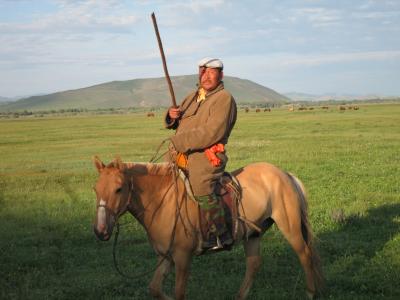
In the late 1100s, the Mongol tribes were split by dissension, a threat to no one but themselves. By the early decades of the 1200s, the tribes had become a united force that rained havoc on its neighbors, expanding in every direction on a wave of horses. Eventually the Mongols would establish the largest land empire in history, ruling over modern Korea, China, Russia, eastern Europe, southeast Asia, Persia, India and parts of the Middle East. To this day the DNA of the Mongols can be found throughout the territories that once made up their empire.
The difference was Genghis Khan, the warlord who united the tribes and launched them on their wave of unstoppable conquest. But the Mongol Empire wasn’t solely the product of Genghis’s will. As a fascinating new study in the Proceedings of the National Academy of Science (PNAS) demonstrates, the rise of the Mongols may have owed just as much to beneficial changes in the climate that made the grasslands of the Mongol steppes green and verdant, fueling the horses that were the backbone of the empire’s military. Climate change helped make the Mongol Empire possible.
The PNAS study came from research done by the tree-ring scientists Neil Pederson at Columbia University’s Lamont-Doherty Earth Observatory and Amy Hessl at West Virginia University. On a research trip to Mongolia in 2010, Pederson, Hessl and their colleagues discovered a stand of stunted Siberian pine trees in the Khangai Mountains. The trees—some of which were still alive—were ancient, some more than 1,100 years old. Old trees provide a living history book of the climate. During warm, wet years, the trees grow more, and the rings inside the trunk that mark those years are wider. The opposite happens during dry years, when the rings would be narrow.
Counting back to the late 1100s, just before the rise of Genghis Khan, the tree-ring data indicated that the Mongol steppes had been in the grip of an intense drought, one that could have helped drive the years of division among the Mongol tribes as they competed for scarce resources. But the tree-rings showed that the years between 1211 and 1225—a period of time that coincided with the meteoric rise of Genghis Khan, who died in 1227—were marked by unusually heavy rainfall and mild temperatures. It didn’t turn Mongolia’s harsh steppes into Maui, but the warmer climate would have stimulated the growth of the grasslands that fed the Mongols’ vital herds of horses and livestock. Given that each Mongol warrior had five or more horses, the energy represented by that additional grass would have helped fuel their astounding rate of expansion.
As Hessl put it in a statement:
The transition from extreme drought to extreme moisture right then strongly suggests that climate played a role in human events. It wasn’t the only thing, but it must have created the ideal conditions for a charismatic leader to emerge out of the chaos, develop an army and concentrate power. Where it’s arid, unusual moisture creates unusual plant productivity, and that translates into horsepower. Genghis was literally able to ride that wave.
Of course, climate change was hardly the only factor in the Mongols’ wave of conquest. Genghis used that supply of horses to form the greatest cavalry force the world had yet seen, one capable of rolling over opposing militaries. But it seems likely that he benefited from that unusual bout of climate change, just as civilizations ranging from the Anasazi in the American Southwest to the Angkor in Southeast Asia were likely laid low by shifts in climate that led to sudden, devastating drought.
In recent decades Mongolia’s climate has been changing even faster than in the rest of the world, with temperatures in parts of the country rising by as much as 4.5 F over the past 40 years. At the same time, the country has been hit by severe summer droughts followed by a dzud, or a long, harsh winter. The same tree rings that revealed the climactic history of the Mongol empire show that the most recent drought, from 2002 to 2009, compares in its severity only to those dry periods in the late 1100s. The droughts and the dzuds have killed millions of animals and ruined the livelihood of Mongolia’s herders, forcing them to more en masse to the swollen capital of Ulaanbaatar. Climate change is still putting Mongolians on the move—but this time, there’s no end in sight.
More Must-Reads from TIME
- How Donald Trump Won
- The Best Inventions of 2024
- Why Sleep Is the Key to Living Longer
- Robert Zemeckis Just Wants to Move You
- How to Break 8 Toxic Communication Habits
- Nicola Coughlan Bet on Herself—And Won
- Why Vinegar Is So Good for You
- Meet TIME's Newest Class of Next Generation Leaders
Contact us at letters@time.com